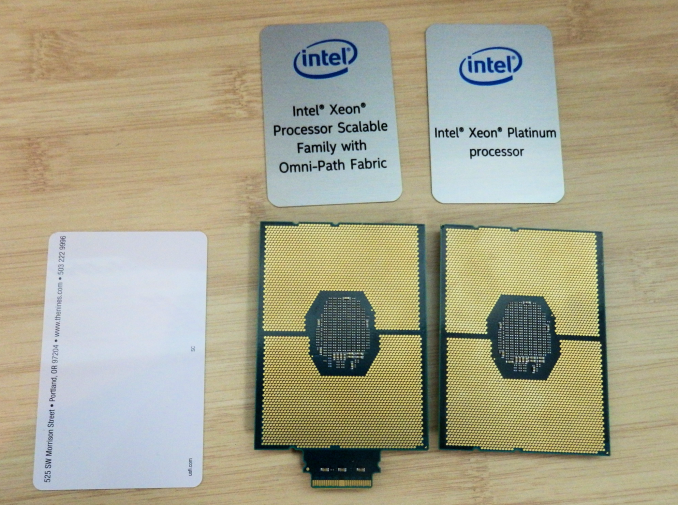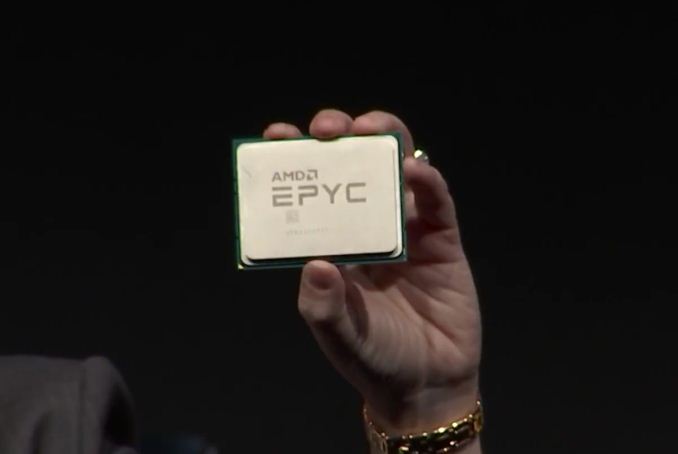Sizing Up Servers: Intel's Skylake-SP Xeon versus AMD's EPYC 7000 - The Server CPU Battle of the Decade?
by Johan De Gelas & Ian Cutress on July 11, 2017 12:15 PM EST- Posted in
- CPUs
- AMD
- Intel
- Xeon
- Enterprise
- Skylake
- Zen
- Naples
- Skylake-SP
- EPYC

This morning kicks off a very interesting time in the world of server-grade CPUs. Officially launching today is Intel's latest generation of Xeon processors, based on the "Skylake-SP" architecture. The heart of Intel's new Xeon Scalable Processor family, the "Purley" 100-series processors incorporate all of Intel's latest CPU and network fabric technology, not to mention a very large number of cores.
Meanwhile, a couple of weeks back AMD soft-launched their new EPYC 7000 series processors. Based on the company's Zen architecture and scaled up to server-grade I/O and core counts, EPYC represents an epic achievement for AMD, once again putting them into the running for competitive, high performance server CPUs after nearly half a decade gone. EPYC processors have begun shipping, and just in time for today's Xeon launch, we also have EPYC hardware in the lab to test.
Today's launch is a situation that neither company has been in for quite a while. Intel hasn't had serious competition in years, and AMD has't been able to compete. As a result, both companies are taking the other's actions very seriously.
In fact we could go on for much longer than our quip above in describing the rising tension at the headquarters of AMD and Intel. For the first time in 6 years (!), a credible alternative is available for the newly launched Xeon. Indeed, the new Xeon "Skylake-SP" is launching today, and the yardstick for it is not the previous Xeon (E5 version 4), but rather AMD's spanking new EPYC server CPU. Both CPUs are without a doubt very different: micro architecture, ISA extentions, memory subsystem, node topology... you name it. The end result is that once again we have the thrilling task of finding out how the processors compare and which applications their various trade-offs make sense.
The only similarity is that both server packages are huge. Above you see the two new Xeon packages –with and without an Omni-Path connector – both of which are as big as a keycard. And below you can see how one EPYC CPU fills the hand of AMD's CEO Dr. Lisa Su.
Both are 64 bit x86 CPUs, but that is where the similarities end. For those of you who have been reading Ian's articles closely, this is no surprise. The consumer-focused Skylake-X is the little brother of the newly launched Xeon "Purley", both of which are cut from the same cloth that is the Skylake-SP family. In a nutshell, the Skylake-SP family introduces the following new features:
- AVX-512 (Many different variants of the ISA extension are available)
- A 1 MB (instead of a 256 KB) L2-cache with a non-inclusive L3
- A mesh topology to connected the cores and L3-cache chunks together
Meanwhile AMD's latest EPYC Server CPU was launched a few weeks ago:
On the package are four silicon dies, each one containing the same 8-core silicon we saw in the AMD Ryzen processors. Each silicon die has two core complexes, each of four cores, and supports two memory channels, giving a total maximum of 32 cores and 8 memory channels on an EPYC processor. The dies are connected by AMD’s newest interconnect, the Infinity Fabric...
In the next pages, we will be discussing the impact of these architectural choices on server software.











219 Comments
View All Comments
JohanAnandtech - Friday, July 21, 2017 - link
Thanks! It is was a challenge, and we will update this article later on, when better kernel support is available.serendip - Tuesday, July 11, 2017 - link
What idiot marketroid thought it was cool to have a huge list of SKUs and gimped "precious metals" branding? I'd like to see Epyc kicking Xeon butt simply because AMD has much more sensible product lists and there's not much gimping going on.ParanoidFactoid - Tuesday, July 11, 2017 - link
Reading through this, the takeaway seems thus. Epyc has latency concerns in communicating between CCX blocks, though this is true of all NUMA systems. If your application is latency sensitive, you either want a kernel that can dynamically migrate threads to keep them close to their memory channel - with an exposed API so applications can request migration. (Linux could easily do this, good luck convincing MS). OR, you take the hit. OR, you buy a monolithic die Intel solution for much more capital outlay. Further, the takeaway on Intel is, they have the better technology. But their market segmentation strategy is so confusing, and so limiting, it's near impossible to determine best cost/performance for your application. So you wind up spending more than expected anyway. AMD is much more open and clear about what they can and can't do. Intel expects to make their money by obfuscating as part of their marketing strategy. Finally, Intel can go 8 socket, so if you need that - say, high core low latency securities trading - they're the only game in town. Sun, Silicon Graphics, and IBM have all ceded that market.msroadkill612 - Wednesday, July 12, 2017 - link
"it's near impossible to determine best cost/performance for your application. So you wind up spending more than expected anyway. AMD is much more open and clear about what they can and can't do. Intel expects to make their money by obfuscating as part of their marketing strategy.Finally, Intel can go 8 socket, so if you need that - say, high core low latency securities trading - they're the only game in town. Sun, Silicon Graphics, and IBM have all ceded that market."
& given time is money, & intelwastes customers time, then intel is expensive.
Those guys will go intel anyway, but just sayin, there is already talk of a 48 core zen cpu, making 98 cores on a mere 2p mobo.
As i have posted b4, if wall street starts liking gpu compute for prompter answers, amdS monster apuS will be unanswerable.
nils_ - Wednesday, July 19, 2017 - link
98 cores on a 2p mobo isn't quite right if you keep in mind that the 32 core versions already constitute a 4 CPU system, unless AMD somehow manages to get more cores on a single die.nils_ - Wednesday, July 19, 2017 - link
Good analysis, although Sun and IBM are still coming out with new CPUs and at least with IBM there is renewed interest in the POWER ecosystem.eek2121 - Wednesday, July 12, 2017 - link
, but rather AMD's spanking new EPYC server CPU. Both CPUs are without a doubt very different: micro architecture, ISA extentions, <snip>Should be extensions.
intelemployee2012 - Wednesday, July 12, 2017 - link
After looking at the number of people who really do not fully understand the entire architecture and workloads and thinking that AMD Naples is superior because it has more cores, pci lanes etc is surprising.AMD made a 32 core server by gluing four 8core desktop dies whereas Intel has a single die balanced datacenter specific architecture which offers more perf if you make the entire Rack comparison. It's not the no of cores its the entire Rack which matters.
Intel cores are superior than AMD so a 28 core xeon is equal to ~40 cores if you compare again Ryzen core so this whole 28core vs 32core is a marketing trick. Everyone thinks Intel is expensive but if you go by performance per dollar Intel has a cheaper option at every price point to match Naples without compromising perf/dollar.
To be honest with so many Fabs, don't you think Intel is capable of gluing desktop dies to create a 32core,64core or evn 128core server (if it wants to) if thats the implementation style it needs to adopt like AMD?
The problem these days is layman looks at just numbers but that's not how you compare.
sharath.naik - Wednesday, July 12, 2017 - link
Agree, Most who look at these numbers will walk away thinking AMD is doing well with EPYC. The article points out the approach to testing and also states the performance challenges with EPYC, which can be missed who reading this review without the prior review on the older Xeons. For example the Big data test, I bet the newbies will walk away thinking EPYC beats the older XEONS E5 v4, as thats what the graphs show,without ever looking back at the numbers for a single 22 core Xeon e5 v4. So yes, a few back links in the article will be helpful.warreo - Wednesday, July 12, 2017 - link
Not a fanboi of either company, but care to elaborate more? I checked the original Xeon E5 v4 review. It shows that a single Xeon E5 v4 performs about 10% slower than a dual setup. Extrapolating that here, that means the single Xeon E5 v4 setup would be right around 4.5 jobs per day, which would make it roughly 50% slower than the dual Epyc and Xeon 8176.Sure, you could argue perf/dollar is better against a dual Epyc setup...but one could make the same argument against Intel's Skylake Xeons? I also wouldn't expect the performance to scale linearly anyway. Please let me know what I'm missing.